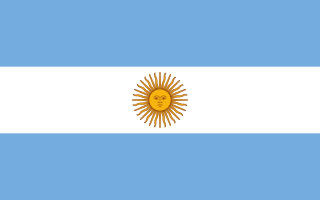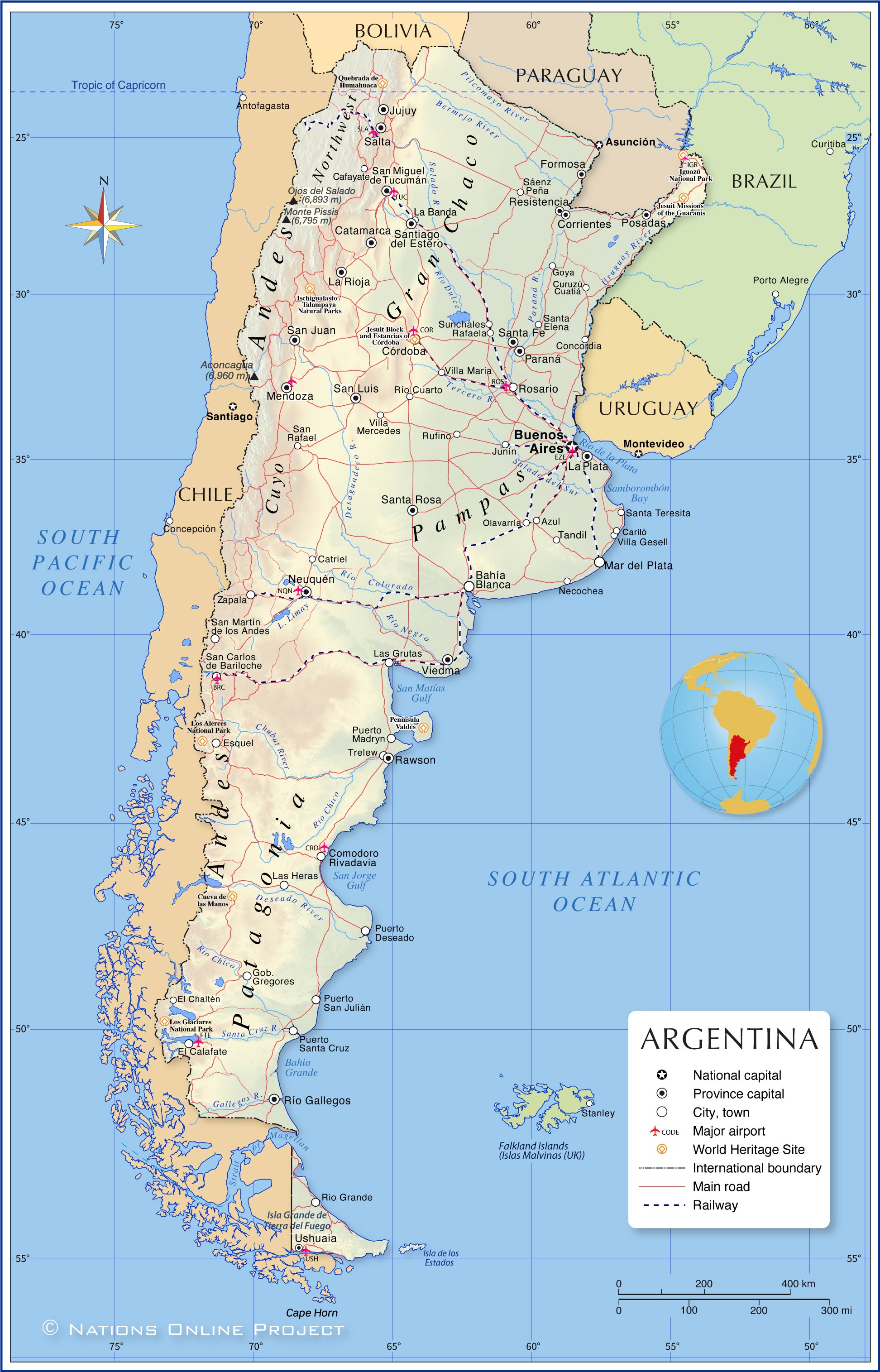

| Official Name | República Argentina | |
| Population | 46 million | |
| Capital | Buenos Aires | (Short for “Puerto de Nuestra Señora Santa María del Buen Aire”) |
| Main Cities | Buenos Aires (pop. 3 million, city only), Córdoba (pop. 1.62 million) | Rosario (pop. 1.59 million), Mendoza (pop. 1.26 million) |
| Area | 1,068,302 sq. miles (2,766,890 sq. km) | Excl. islands in the South Atlantic and a portion of the Antarctic |
| Geography | Argentina is located on the Southern Cone of South America. | Bordering countries: Bolivia, Paraguay, Chile (divided by the Andes mountain range), Brazil, and Uruguay |
| Climate | Ranging from hot subtropical in the north to cold Antarctic in the south | |
| Population Density | 17 inhabitants per sq. km | Despite a low pop. density overall, 92% of the pop. are concentrated in urban centers. |
| Language | Castellano | (Castilian Spanish) |
| Religion | The official religion is Catholicism. | Roman Catholic 62.9%, Evangelical 15.3%, None (includes atheist and agnostic) 18.9%, Judaism and Islam 1.5%, Other 1.4%. |
| National Holidays | Independence Day, July 9 | Day of the May Revolution, May 25 |
| Government | Argentina is a federal republic with 23 provinces and 1 autonomous city (Buenos Aires). The president is head of state. Each presidential term lasts four years. | There are two chambers: the Senate (Cámara de Senadores) representing the 23 provinces and the autonomous city of Buenos Aires, and the House of Representatives (Cámara de Diputados) representing the population on a proportional representation basis. |
| Currency | The peso. There are 100 cents (centavos) to the peso. | Notes: 2, 5, 10, 20, 50, 100, 200, 500, and 1000 pesos. Coins: 1, 2, and 5 pesos and 1, 5, 10, 25, and 50 centavos |
| Media | Main newspapers include Clarín (popular daily), La Nación (conservative daily), Cronica (tabloid daily), La Prensa (Argentina’s oldest newspaper). Télam is the state run news agency. Infobae is a popular online news portal. | Argentina’s media is generally free from censorship, according to Freedom House. A measure of self-censorship may be employed in crime stories where the threat of violence is possible. |
| English Language Media | Buenos Aires Herald | Buenos Aires Times |
| Electricity | 220 volts, 50 Hz | Two types of plugs: 2-pronged (rounded) in older buildings; 3-pronged (flat) in newer houses. |
| Internet Domain | .ar | |
| Telephone/Time | Country code: 54 | GMT -3 |
Contrary to the typical South American imagery of palm trees and tropical beaches, Argentina offers a diverse and captivating landscape. It may seem unconventional to associate a Latin American nation with both skiing and cold winters, as well as hot and humid summers, but Argentina’s unique blend of geographical features makes it an extraordinary and memorable destination.
As the eighth-largest country globally and the second-largest in South America (after Brazil), Argentina spans nearly 2,300 miles (3,700 km) from its northern to southern extremities. This vast expanse contributes to a remarkable array of climates, terrains, and geographic wonders.
The Andes mountain range runs along the western border, separating Argentina from Chile. Stretching from the northwestern corner to the southern tip of the country, the Andes create distinct regions. The Puna, a vast plain situated at an average elevation of 10,499 feet (3,200 meters) above sea level, occupies the northwestern corner near the borders with Bolivia and Chile. Traveling south along the Andes leads to the snow-capped mountains of Cuyo, where heavy winter snowfall often blocks mountain passes. Notably, the highest peak in the Andes and South America, Mount Aconcagua, stands at 22,831 feet (6,959 meters) in this region.
Moving further south brings one to Patagonia, characterized by lakes, forests, and rugged mountain peaks resembling an Alpine setting in the west, and a vast semi-desert plain to the east, extending toward the Atlantic Ocean. Towards the southern tip, the journey to Tierra del Fuego offers breathtaking views of glaciers, including the impressive Glaciar Perito Moreno.
Patagonia, rich in biodiversity, attracts nature and wildlife enthusiasts with its diverse fauna, including whales, penguins, and numerous bird species. Conservation efforts are underway to protect the region’s wildlife, which faces the threat of declining populations and potential extinction.
REGIONS AND CLIMATE
Argentina’s extensive latitude range of 34 degrees contributes to diverse climates from north to south. From the hot subtropical climate in the northwest bordering Bolivia to freezing temperatures in the southern glacier regions, visitors are advised to pack accordingly.
- THE NORTHWEST
- The mountainous region, encompassing provinces like Jujuy, Salta, and Catamarca, features hot climates and vibrant landscapes rich in historic relics.
- The high plains of Puna, reaching elevations of 9,843 to 11,483 feet (3,000 to 3,500 meters), offer a hot climate during the day but experience sharp temperature drops at night.
- The Eastern Andes boasts famous quebradas (valleys), such as the UNESCO World Heritage Site Quebrada de Humahuaca.
- THE EAST AND NORTHEAST
- Traveling east reveals subtropical forests in Formosa and Chaco with a hot and humid climate.
- The rivers Paraná and Uruguay border provinces like Misiones, Corrientes, and Entre Ríos, forming the region of Mesopotamia with historic Jesuit ruins and diverse cultural influences.
- CUYO
- Located halfway down the country, the Cuyo region includes provinces like Mendoza and San Juan, offering varied climates influenced by the Andes.
- Mendoza is renowned for its wine production, and the region features unique landscapes like the Ischigualasto park, known as the “Valley of the Moon.”
- THE PAMPAS
- The Humid Pampa, comprising provinces like Buenos Aires, Santa Fe, and La Pampa, is a center of agricultural activity with flat terrain and a temperate climate.
- Tandil and Ventana regions have low hills, and temperatures range from hot and humid summers to freezing winters.
- THE WEST AND SOUTH
- Tierra del Fuego experiences extreme temperatures, from about 5ºF (–15ºC) in winter to 64ºF (18ºC) in summer.
- Western regions along the Andes, from Mendoza to Tierra del Fuego, provide ideal conditions for winter sports, hosting various ski resorts.
THE ARGENTINIANS: A DIVERSE BLEND
Argentina’s society reflects a rich tapestry of cultures, with a mix of Spanish, Italian, German, French, British, and more recent Korean, Chinese, Paraguayan, Bolivian, Colombian, and Venezuelan immigrants comprising about 97 percent of the population. However, Afro-Argentinians and other ethnic minorities, including descendants of Indigenous peoples, represent a small minority.
- THE ITALIANS AND SPANISH
- Waves of immigrants, particularly from Italy and Spain, have significantly influenced Argentine society.
- Surnames, local slang, and cultural elements bear traces of Italian and Spanish heritage.
- Over 800,000 Argentinians hold Italian citizenship, maintaining strong ties to their ancestral roots.
- THE ENGLISH, SCOTS, AND WELSH
- The British community played a crucial role in commerce, trade, and industry, contributing to Argentina’s development.
- Despite a brief period of tension during the South Atlantic War in 1982, the Argentine-British community remains integrated and respected.
- Scots, Welsh, and English immigrants left a lasting impact, evident in place names, traditions, and contributions to sports like soccer, rugby, hockey, golf, tennis, and polo.
- THE WELSH IN PATAGONIA
- The Welsh, settling in Patagonia in 1865, sought economic prosperity while preserving their language and customs.
- Welsh tea houses, music, Eisteddfods, and the Welsh language remain integral to this community.
In conclusion, Argentina’s geographical diversity, climatic variations, and cultural amalgamation make it a captivating destination where visitors can explore a rich tapestry of landscapes and histories.
